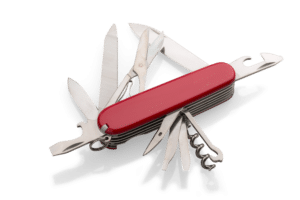The world around us is changing profoundly, and education must adapt to it. In an age of growing uncertainty, a wise strategy would be to hedge against upheavals by embracing versatility.
A K-12 education today must equip learners with the abilities to tackle life challenges, ranging from social and political issues (global warming, pollution, inequities, etc.) to technology’s evolution (Social Networks, and now particularly Artificial Intelligence). As such, education is NOT training [with a respectful nod to former MIT Professor Woodie Flowers, R.I.P.]; education is broad and life-related at large, while training is narrow and job-related (and starts partially in high school). Of course, education and training are both needed eventually, but mustn’t be conflated as they have different goals (psychosocial-focused for education, economic-focused for training).
Because the future is unknowable, cultivating versatility is a wise and appropriate strategy—think of it as a “hedge against all eventualities.” Using a Swiss army knife analogy, it’s best to equip learners with a broad set of tools that can be sharpened as the circumstances require—poet, physician, painter, and physicist.

How wiser? By redesigning the ‘What,’ not just the ‘How.’
Wisdom is, more than ever, the goal of education. But to get there, it’s necessary to redesign both standards/curricula (the “What”) and pedagogy (the “How,” which is not treated in this short blog), as there are significant gaps between emerging needs and current practices.
The What:
Education hasn’t yet fully adapted to the Information Age; for example, though called “STEM,” only “St_M” is taught in K-12—very little Technology and no Engineering. Twenty-five years into the Internet Age, which David Houle called the Shift Age, modernity requires rapid adaptation to changing information, and dealing effectively with a diversity of languages, cultures, and lifestyles. And with the AI age, the accumulated deficit of the past two ages (Industrial, and Information, neglecting deep curricular adaptations) comes back even more forcefully, augmented by a new set of challenges.
As a result of this inertia, some will argue, perhaps to temper their cognitive dissonance, that the “What” doesn’t matter “as long as you learn.” At the Center for Curriculum Redesign (CCR), the organization I lead, we profoundly disagree: why focus the teaching on old content if better options are available? For example, why waste time learning advanced trigonometric functions that matter to very few, and have been largely automated, rather than data science, which is useful across many disciplines and is in hot demand?
All four dimensions matter:
Harvard’s Chris Dede summarizes the situation well: “The current curriculum and high-stakes tests often prioritize fostering skills at which AI excels, such as reckoning skills involving calculative prediction and formulaic decision-making. However, AI cannot easily replicate human judgment, which is a deliberative thought process that is flexible and contextual based on experiential knowledge, ethics, values, relationships, and culture.”
As described in CCR’s 2015 book Four-Dimensional Education, this means paying attention to all four dimensions of Education: Knowledge, Skills, Character, and Meta-Learning.
Knowledge: Declarative knowledge is more challenged than ever by large language models (LLMs), which amplify historical trends (scripts, books, Internet, search engines). As explained earlier, it doesn’t mean that humans don’t need base knowledge, it means they need to be a lot more discriminant about what is essential and relevant.
Also, and counterintuitively, there is a need for a broader set of declarative knowledge to respond to the need for versatility. David Epstein, author of Range, contrasts “kind” and “wicked” learning environments, explaining that while structured, predictable “kind” environments can favor early specialization, real-world “wicked” environments often reward a wide range of experiences. He also stresses that a sampling period, where one explores various interests before settling on one, can lead to more career satisfaction and success. Epstein argues against early specialization in education, stating it can limit children’s ability to explore their potential and adapt to new situations; and investigates “match quality”—the fit between one’s interests, abilities, and career, and how a broad range of experiences can enhance it.
However, it is crucial to state an ‘and’ mindset at this stage: Per IBM Research’s T-shaped model, it’s perfectly possible to build depth AND breadth, not one or the other—expertise AND transfer. This is CCR’s position: LLMs increase the pressure toward teaching more conceptual knowledge (core concepts) and procedural knowledge (projects). Success at medical, legal, and other tests highlights the significant extent to which these tests are based on memorization of declarative knowledge (to be fair, coupled with some deductive capacities).
Competencies:
- Skills: Both challenged and augmented by AI.
- Character: Some remain significantly human (for instance, ethics) and must be leaned on, while others are helped and pushed (for instance, curiosity).
- Meta-Learning: Learning how to learn is more critical than ever, as are metacognition and metaemotion.
In addition to the goals of modern education described by the Venn diagram above, there’s also a growing need to personalize education. This personalization comprises four drivers: Motivation, Identity, Agency, and Purpose—of which motivation and purpose will remain quintessentially human.
In summary, to fully embrace the transformative potential of AI in education, we must rethink both what we teach and how we teach, ensuring that students are not only prepared for the jobs of tomorrow but also equipped to navigate the complexities of life with wisdom. Adaptability and self-directed, continuous learning are key. This also means fostering both depth and breadth in learning, where students develop specialized expertise and activate transfer, while also gaining the skills, character and meta-learning abilities needed to thrive in an unpredictable world. By prioritizing these four dimensions—Knowledge, Skills, Character, and Meta-Learning—and by personalizing education and enhancing student motivation through the three drivers of Identity, Agency, and Purpose, we can create an education system that is truly responsive to the demands of the 21st century and beyond.
The Innovative Potential (by Thomas Arnett, Senior Research Fellow at the Clayton Christensen Institute):
Charles Fadel’s commentary is a valuable and much-needed contribution to the broader conversation about AI’s impact on K-12 education. While many discussions on this topic remain at a high level, Charles and his colleagues have taken the critical step of providing a thorough and detailed analysis of what specifically needs to change in terms of the curriculum and the learning experiences for students. This blog post offers just a glimpse of their insightful ideas, and I highly recommend that readers who are intrigued by these concepts explore them further by getting a copy of their book, Education for the Age of AI.
However, as we contemplate the significant shifts that Charles advocates for, an important question arises: What will it take to get education systems to adopt these changes in curriculum and pedagogy? On one hand, as the challenges posed by AI become more pressing and change accelerates, it may be possible to muster the political will for a society-wide consensus that drives legislative action at state and federal levels. But waiting for such political momentum, which may or may not align with the timeline we need, should not be our only strategy.
In the short term, I believe these changes may find their greatest traction among those who are actively working to build new models of schooling within new value networks. Instead of waiting for conventional education systems to undergo a massive shift in priorities, the initial footholds of change may emerge more quickly in spaces incubating unconventional models of schooling—such as hybrid virtual learning, microschools, and alternative education. These environments often have the best opportunities to escape the constraints of conventional education and integrate forward-thinking ideas like those Charles describes. As these new models gain momentum, they can serve as proof points that may eventually influence broader systemic change.
This blog is a modified extract for the Christensen Institute from the Center for Curriculum Redesign’s (CCR) recent book: Education for the Age of AI. To learn more, check out the link below.



